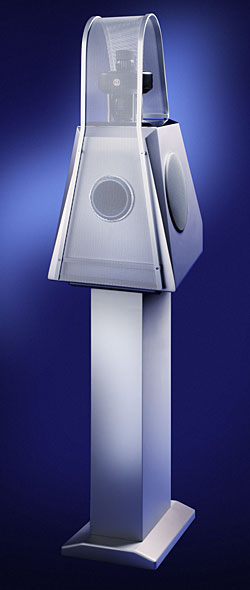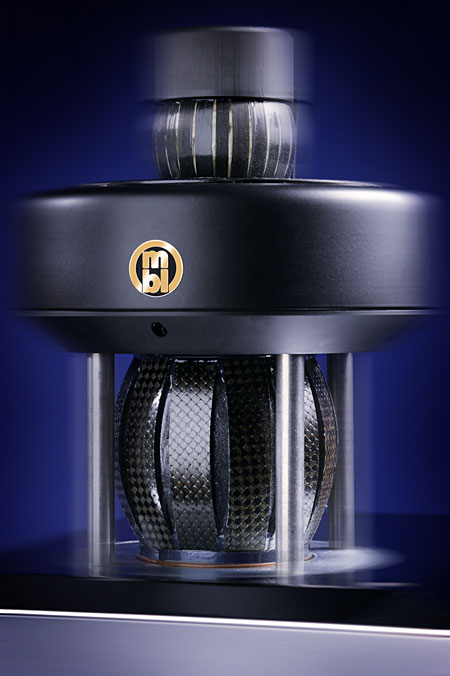mbl Radialstrahler 116/121/111RC 5 Channel Surround Sound System Page 2
 Call me crazy (join the crowd), but I'm not about to give up that big "old fashioned" CRT for any currently available flat panel or rear projector fixed pixel device, though a front projection system is probably up next.
Call me crazy (join the crowd), but I'm not about to give up that big "old fashioned" CRT for any currently available flat panel or rear projector fixed pixel device, though a front projection system is probably up next.
Except for the big TV (which, for an omni-directional speaker is a big "except"), the placement was in line with mbl's directive ("suggestion" doesn't work for a German product). And with no side wall in sight (the closer one is 15 feet away) the 116s had plenty of open space in which to operate. Bi-wiring is supported, but I ran the 116s with the binding posts jumpered.
Finding a home for the 111RC center speakers proved a far bigger problem. Due to its vertical construction, placing it atop the CRT put the midrange/tweeter array's center point a full 6'4" from the floor and more than three feet above the L/R speaker mid/tweeter array. Stand mounting it in front of the screen was also impossible since at 23" tall, it reached the bottom of the screen when placed on the floor and floor placement was out since the speaker's LF output was tuned for off the floor placement. Therefore, atop the television it went. This was my problem. It certainly wouldn't be yours if you have a front projection system. Right now the importer is reading this and freaking out. But not to worry!
The 121s went where every surround speaker has gone in this room: on stands located on either side of a large sectional, aimed directly at the listening position (though of course with omni-directional speakers there no such thing as "aiming").
Keep in mind that because of the omni-directional radiating pattern, the final results you obtain with these speakers, especially in terms of overall tonal balance, will be more dependent upon where you place them than with conventional direct radiating speakers. "Lively" rooms will cause the high frequencies to bounce around and be accentuated, especially if the speakers are placed in close proximity to a wall. In fact, both reflective and interference effects will be intensified, which is why mbl specifies a different distance between the front and side walls. My Lexicon RV-8 receiver was configured to THX 80Hz specs, though the L/R speakers were run full range to take advantage of their full range capabilities.
Listening To Outer Space
Once the levels had been adjusted and the subwoofer dialed in, it just so happened that the first piece of music I heard through the MBL system was the familiar 20th Century Fox fanfare at the beginning of a movie (the abysmal The Devil Wears Prada—didn't finish watching). Yikes! The snare drum rolls and the horn flourishes have never sounded so fast, smooth and real in this room, nor has the presentation appeared so massive, spacious, seamless and complete.
Nor has the volume on the Lexicon RV-8 receiver ever been turned up so high to get reasonable SPLs. That's the first thing you should know about this mbl technology before you become too enthralled by the rapturous sonic description soon heading your way. These speakers are very inefficient. The 116s are rated at 83dB/W/m, which means that even with 140 genuine watts per channel, with all channels driven, the maximum SPLs likely to be generated are around 100dB or so. To really get these speakers cranking you'll need at least 500 high quality watts per channel and preferably more, given their 4 ohm load and high current demand. The 121s are an additional dB lower in efficiency.

Also keep in mind that maximum SPLs for these speakers is approximately 106dB, so if you like it really loud, or if your listening/home theater room is unusually large, you probably should look elsewhere (or discuss the particulars with an mbl dealer). However, because of their omni-directionality these speakers tend to sound subjectively louder than they measure. Take it from me: I sometimes like it loud, and even with a scant 140-watts per channel the system met my demands.
Before we get to tonal balance, dynamics and the like, let's get one thing clear: throw away any superlatives you may have read about other speakers' abilities to create "acoustic bubbles," "seamless three-dimensionality" and the like. Nothing I've heard through the years comes close to what these mbls produce in terms of space, "acoustic bubbles," " three dimensionality", "seamlessness" and other oft-written surround sound criteria. The sound was everywhere and coming from nowhere. Yet when image specificity was called for it was there, where it belonged.
As I write this I'm listening to a multichannel SACD organ spectacular someone handed me in Germany last spring called Phantomes, performed by Harald Feller on a recently installed Goll organ in a Lucerne church (OEHMS Classics OC606). Yes, it has "The William Tell Overture," "Toccata and Fugue in D Minor BWV565" and a "Star Wars" suite, but it also has a sublime twelve minute organ sonata written by the late Nino Rota. And anyway, the "Star Wars" suite rocks and the recording is stupendous.
The presentation of this recording by these mbl speakers was dramatically open, unforced, non-mechanical, "the floor has fallen out, the ceiling gone and the walls have disappeared" transparent, and both expansive and appropriately contained in a supremely well-defined acoustic. The REL subwoofer's contribution to the visceral bottom end shouldn't be overlooked. But it is the mbl's speed, transparency, purity, and omni-directionality which produces a sound both location-less and image specific, depending on the needs of the program material—whether that sound is from an audiophile recording produced in a church, or a multichannel studio extravaganza like Beck's Sea Changes (DGC 0694935372 non-hybrid SACD). I've never before heard that recording, and its surround mix, engineered by Elliot Scheiner, float so effortlessly in three dimensions or sound so well-textured and pleasingly delicate and ephemeral, with events appearing and receding magically into the musical ozone.
Pink Floyd's Dark Side of the Moon SACD has usually sounded somewhat fragmented and disjointed when split into multiple channels. But cranked up through this system the presentation was whole, pure, and dimensionally fully expressed, even though sound did not appear to be emanating specifically from any of the speakers.
In fact that's what this system did better than any other surround system I've heard, and as good as the big mbl 101 was in a two-channel setting. The Radialstrahler's omni-directional advantage really made itself felt in a multichannel system. No matter what the visual distractions in your room, even with the lights on, you can stare at the speakers and hear nothing coming out of any of them, yet the immersive illusion of reality is startlingly real.
Despite years of surround sound listening in this room, when a big jet roared across the rear channel speakers during an NFL football game we all jumped, thinking a plane was about to crash outside. That's how truly omni-directional, non-directional and flat out believable these speakers are.
Even with the center channel speaker perched atop the RPTV, RCA's three channel "Living Stereo" recordings on SACD were presented seamlessly across the soundstage, thanks in part to the true omni-directional nature of the midrange/tweeter array that also produced rich, supple harmonics and fast, yet etch-free transients.
The system produced movie magic too. Despite the center channel's unfortunate height, dialog was as natural, unforced and easy to understand as I've heard here. Male voices were free of chestiness and female voices never sounded thin, shrill or overly sibilant unless the recording was. Aside from its subjectively ideal tonal balance, the 111RC never "sounded." As with the other channels, the vocal images simply floated like a holographic bubble, with solidity and form but not with identifiable edges or etch. Whatever the measurements might show, the observational sensation was of tonal effortlessness and believability.
Of course when there was well-recorded music, dialog, and an enveloping surround track, the system produced a level of cinematic involvement and intensity unique in my experience, which dates back to the earliest days of Dolby Surround. I stopped jumping from surround effects years ago. This system got me started again.
Panned effects moved fore and aft, side to side and diagonally with unrivaled seamlessness and specificity. As far as sonic envelopment helping one to get "into" a movie, no other surround system I've heard comes close.
Were there any down sides to this mbl system aside from the cost and the need for prodigious amounts of power? There was one: at low SPLs, at least with the quality and amount of power the Lexicon RV-8 provided, dynamics flattened, the sound field collapsed and went limp and worst of all dialogue became unusually difficult to understand (even with the stand at ear level).
So the worst that can be said about the mbl system is that it makes for poor late night listening. By the time you get the volume up to where dialog intelligibility returns, the wife is awake and that's not a good thing.
Otherwise, this mbl system set a new surround sound standard in my home theater. Its overall performance, both tonally and especially spatially for both movies and music, was in a league of its own, and by a wide margin. If you can afford it (or a more compact and somewhat less expensive system consisting of four stand mounted 121s, a 111RC and your choice of subwoofer), and your room's configuration is appropriate for its specific placement needs, this mbl system will blow you away the first time, and every time.
Conclusion
Whatever high hopes I had for an mbl Radialstrahler-based surround sound system (and they were high) were more than met by this magical combination. In terms of three-dimensional seamlessness, textural palpability, harmonic sophistication and overall transparency, nothing else in my experience comes close. Pressed to describe its spectral balance on one side or the other, I'd say the system was on the warm and lush side, but with plenty of detail and ideal transient response. Again, because of the omni-directionality, the balance you obtain will be highly dependent upon placement and adjacent reflective surfaces.
Other systems will play louder, but this one played loud enough. Other systems can probably deliver greater dynamic thrusts, but this system was dynamic enough and if you add a truly capable subwoofer, you'll have few or no complaints about any of what it does.
It's the first system I've had in my home theater that made me want to sit and listen to music there instead of heading downstairs to my two-channel room. Great movie soundtracks came alive as never before and lousy ones became tolerable. Don't skimp on the amount and quality of the power you provide for this special system and you will be rewarded with the sonic surround ride of your life. And if you can afford to base a system around a pair of 101Es, or five of them, please invite me over!
Highs
Intoxicatingly pure high frequencies
Huge, focused sound field
Omni-directionality makes them disappear
Lows
Expensive
Extremely inefficient
Dialog intelligibility suffers at low volume
- Log in or register to post comments





























































